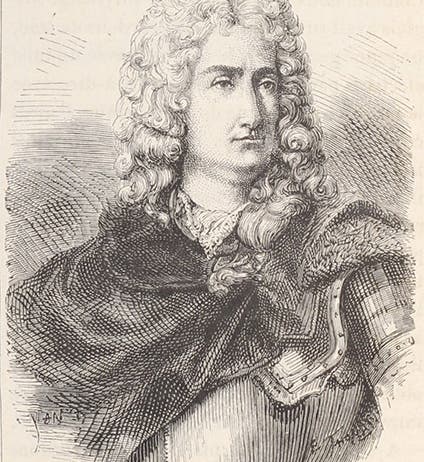Scientist of the Day - Charles du Fay
Charles-François de Cisternay du Fay, a French physical scientist, was born Sep. 14, 1698. We see above a portrait that was printed in a late 19th-century history of technology. Du Fay (sometimes Dufay) was one of the pioneer investigators of electrical phenomena in the crazy decade of the 1730s, when no one had a clue what electricity was. The standard tool for the electrical investigator was a glass rod, which was rubbed vigorously with a piece of cloth. The electrically charged rod could then be used to electrify other objects, such as bits of chaff and fluff, or even a small boy, provided he was removed from ground by being suspended from silk cords. The illustration below, depicting such a demonstration, is from a slightly later popular electrical work by Abbé Nollet. That is a glass rod that the experimenter is waving around, not a light saber.
More typically, when electrified children were not available, the person with the rod would stick to his chaff and fluff, which, once contact had been made with the rod, would be repelled by the rod, and could be chased merrily around the room by the rod-wielding experimenter. Du Fay was doing experiments like this in the early 1730s, but so were dozens of other investigators. It was also known that you could do similar kinds of demonstrations with a gum resin rod instead of a glass rod. The resin rod had to be rubbed with a piece of fur instead of cloth, but once it had been electrified, you could do exactly the same experiments and demonstrations with the resin rod that you could do with glass.
In 1733, du Fay discovered something that all other experimenters had missed, although it was right under their noses: the electrified resin rod would attract the chaff that was repelled by the glass rod. Similarly, chaff that was repelled from a resin rod would be attracted to a glass rod. There were apparently two different kinds of electrical fluid, with opposite electrical properties. Du Fay called them vitreous (glass-like) and resinous, and du Fay became the foremost proponent of what was soon called the two-fluid theory of electricity. Between 1733 and 1737, du Fay published a series of 8 papers setting out his two-fluid theory in the Memoires of the Royal Academy of Sciences in Paris. We have all these papers in our serials collection at the Library. In 1745, his papers were translated into German and published in a single volume in Erfurt. We have that work in our History of Science Collection as well.
Du Fay was a very clever man, and quite astute to observe that a piece of chaff electrified by a glass rod has different properties from one electrified by resin. But du Fay was not a genius. Benjamin Franklin was. Around 1750, Franklin suggested that there is only one electrical fluid, with a positive charge (Franklin invented that term), which is self-repulsive, and that ordinary matter has a negative charge. Electrical fluid is normally present in all matter, and the two balance each other out. When you rub a glass rod with a cloth, some of the fluid is rubbed from the cloth to the glass, so that the glass rod now has a positive charge. With a resin rod, some of the fluid is wiped from the rod to the fur, and the resin rod now has a negative charge. Both rods are electrified, but in opposite ways. Every one of the effects with chaff can be explained, but you only need one fluid to do it. The one-fluid theory had such explanatory power that, after 1760, no one looked back to du Fay and his two-fluid hypothesis. Du Fay’s ingenious theory had come with a 25-year lifespan. We have since reversed the positive and negative conventions that Franklin adopted, so that the electrical fluid is considered negative instead of positive, but otherwise, Franklin’s one-fluid theory is pretty much still in place.
Dufay did not live to see his hypothesis abandoned. When he died of smallpox in 1739, at age 40, Ben Franklin’s entrance into the field of electrical experimentation was still 8 years in the future.
Dr. William B. Ashworth, Jr., Consultant for the History of Science, Linda Hall Library and Associate Professor emeritus, Department of History, University of Missouri-Kansas City. Comments or corrections are welcome; please direct to ashworthw@umkc.edu.







